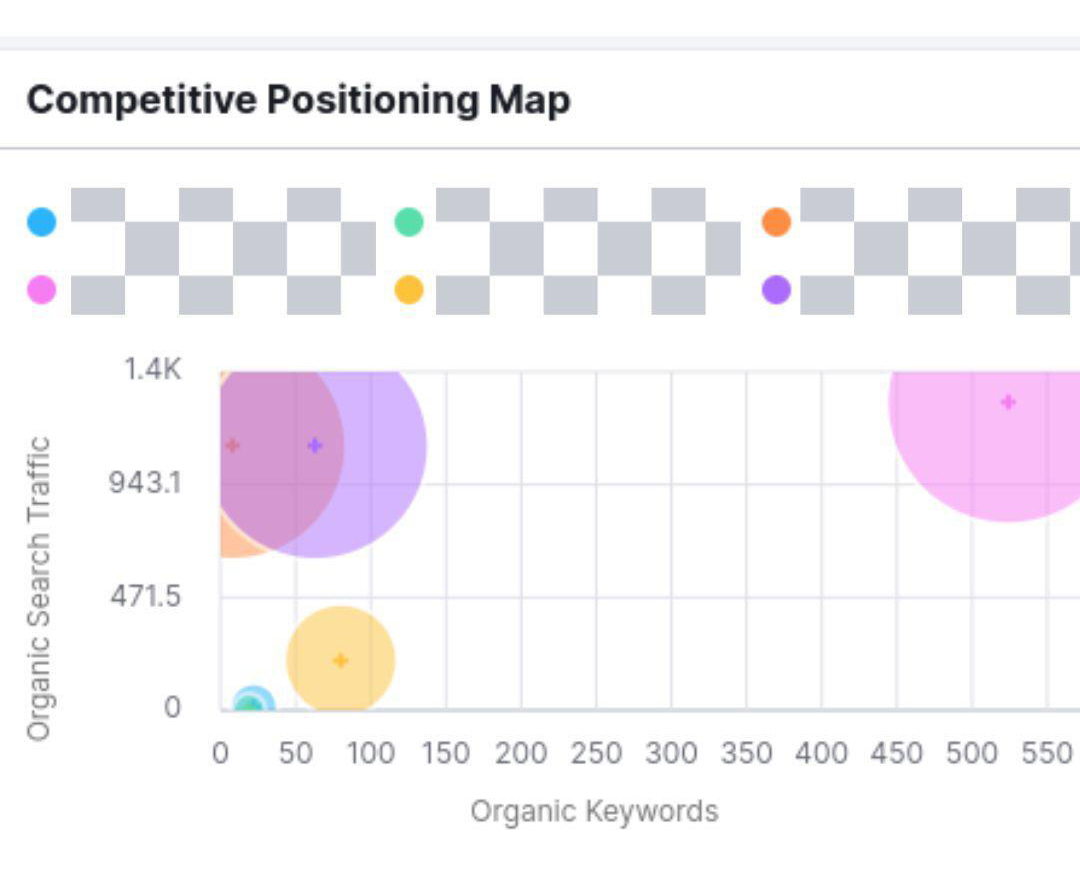
SEO isn’t the same as it was a few years ago! You can no longer stuff keywords in your content and expect to rank higher in the SERPs. With more and more websites popping up and the ever-evolving Google Search algorithm, it’s becoming increasingly tough to rank higher.
However, with comprehensive SEO strategy planning, you can outshine your competitors and rank higher in the search engine results. And this blog is there to help. Below, we’ll discuss what an SEO strategy is, what benefits it brings, and how you can create an effective SEO strategy tailored to your business.
What is an SEO Strategy?
An SEO strategy is a plan designed for content creation, optimization, and promotion. The aim is to enhance a website’s visibility in search engine result pages. The strategy planning helps attract more organic traffic to a website. This involves various techniques like keyword research, technical SEO, on-page optimization, local SEO and link building. In other words, an SEO strategy is the process you follow to increase organic traffic to your site. If you are seeking expert assistance, get in touch with professional SEO consulting services .
Mobile SEO Strategy
Mobile SEO, as a part of your overall strategy, is crucial to guarantee that your site and content are easily accessible to mobile users. The experience is almost the same as that on the desktop. Google uses mobile-first indexing; which prioritizes your site’s mobile version for indexing as well as ranking in Google’s search results.
Even for consumers, mobile SEO is beneficial. According to the 2023 Web Traffic & Analytics Report, 54% of consumers use their phones most frequently for search queries. Their searches often lead to purchases. Therefore, optimizing your site for mobile users is vital for dominating the digital market.
What do Experts have to say?
Mersudin Forbes, an experienced SEO director, emphasizes the importance of matching the expectations and needs of mobile consumers. Most search engines adopt mobile-first indexing, which makes it critical to optimize content as well as functionality for mobile devices.

Expand Your Business Online With Advanced SEO Strategy
What Are the Benefits of an SEO Plan?
Implementing a well-planned search engine optimization strategy has various advantages for your online presence. Optimizing your website for Google allows you to:
- Drive targeted traffic: An effective SEO strategy boosts your website’s organic visibility, bringing in relevant people actively looking for your products or services. This customized traffic improves the chances of conversions and business growth.
- Improve brand awareness: Higher search engine ranks boost brand visibility. When your website appears on the first page of organic search results. This builds user trust and confidence, which results in increased brand recognition.
Are you struggling to find the best SEO company, contact the expert team at WillShall.
Basic SEO Strategy
1. Create a Keyword List
Use Google Autosuggest and make a keyword list, which delivers useful suggestions from Google’s search box.

This is an indication of genuine user interest. Moreover, try focussing on long-tail keywords as they are less competitive than broader terms. Try leveraging tools like Semrush or Ubersuggest to assess search volume and the level of competition to improve your overall SEO strategy.
2. Examine Filters Generated by Google

When searching for your primary keyword, such as ““local SEO services,” make sure to look into Google’s unique filters. These filters differ from the traditional ones such as Shopping, Images, etc. They are meant to provide insights into customer searches associated with your keyword.
Examining Filters Generated by Google can help answer such questions:
-
-
- What are the associated inquiries that users are looking into?
- What content would be most useful to them?
-
Assessing if your product or service answers these questions allows you to personalize offerings more efficiently. This approach supports creating product pages tailored to individual needs. Thereby, it helps to improve their overall browsing experience and potential engagement.
3. Discover Your Competitors
Use Semrush to simplify SEO competitor analysis. It will help you understand what your competitors are doing right.
-
-
- To get an overview of your site’s performance, first go to the “Domain Overview” and enter your URL.
-

-
-
- Scroll down to the “Main Organic Competitors” column, which displays websites that rank for similar keywords and target audiences.
-

-
-
- Click “View all” to learn more about competitor details, such as common keywords and traffic numbers.
- The “Common Keywords” function displays the total amount of terms shared with each competitor.
-
This helps discover potential competitors. By the end of this process, you should have identified at least 4-6 main organic competitors for further analysis.
4. Build Online Authority
In SEO, authority is crucial, comprising expertise, experience, authority, and trustworthiness, all of which are prioritized by Google in its Search Quality Rating standards. Just creating SEO-optimized content is not enough, you must establish your authority.
To build authority for a new website or company, follow the mentioned strategies:
-
-
- Publish your content across various platforms including LinkedIn, Instagram, and your website.
- Partner with niche-specific freelance writers and display their expertise on your website.
- Build a digital profile by posting guest writings on authoritative blogs and websites.
- Cover every topic on your niche for example you are a digital marketing company then it is important to write blog on every topic in digital marketing.
-
Google’s algorithm cross-references various online sources to verify authority, so make your credentials public and easy to access. For instance, include your experience on the “About” page, contribute frequently to prominent marketing blogs, start a podcast or blog, produce an ebook, and work with expert developers, promoting their contribution to your project.
As you gain authority, continue to create high-quality material, as discussed in the next step.
5. Develop User Optimized Content
Developing User-optimized content is important for any SEO strategy. However, to achieve high SERP rankings, you need on-page content optimization around target keywords. You can try using tools like Semrush to find out potential keywords. However, don’t forget to focus on long-tail keywords discovered during the early process of your research. When creating content, make sure you prioritize readers’ interests and needs. Answer their queries and address search intent.
Below are some fundamental practices:
-
-
- Keyword Placement: Use your target keyword in the page title, H1, first line of text, meta description, and URL to assist Google in comprehending your content.
- Helpful Content: Provide valuable information that satisfies the reader’s needs. Use your competition and SERPs to figure out what users are looking for.
- Image Optimization: Use alt text with keywords for photos to boost accessibility and rank higher in Google’s image search. Compress images to improve page loading speed.
- Internal Linking: Build a strong internal linking system to help users and search engines explore your website. This strategy, known as the pillar-cluster model, can greatly improve your SEO by suggesting topic-related information and authority to Google.
-
What do Experts have to say?
Nedim Mehic, an experienced SEO expert and the founder of Beki AI, an internal linking software, emphasized that internal linking remains the base of effective SEO strategies in 2024. He confidently asserts that in 2024, internal linking will remain a pillar of effective SEO strategies.
We achieve two key goals by carefully interlinking pages: “We help users browse the site easily, and search engines understand and organize our content more effectively.” This combined benefit improves both user experience and search engine comprehension. Aside from these benefits, improved internal linking can lead to considerable results. Mehic has witnessed various websites succeed after improving their internal linking tactics, which were neglected for years.
Mehic highlighted an instance from Beki AI’s beta test phase in which a user witnessed an 800% boost in clicks after adding relevant internal links to a low-traffic page. This pretty much demonstrates the power of an effectively carried out internal linking strategy. For more information, contact the technical SEO services expert team near you.
6. Build Backlinks
Content takes the front seat, but backlinks are the primary support system. Even the best SEO-optimized website requires backlinks, or “votes” from other sites, to rank favorably on Google. Backlinks are important since they quantitatively establish authority in your sector. The more backlinks you have, the more powerful you seem to Google’s algorithm because a site will not connect to you unless you are a legitimate, trustworthy source.
Here are some effective backlink strategies:
-
-
- Guest Blogging: Write guest posts on other web pages and link back to your own.
- Create Link-Worthy Content: Write informative and useful content that others will want to turn to and link to.
- Original Research: Conduct and share unique studies that other industry professionals will find useful and link to.
- Co-Marketing Campaigns: Collaborate with other companies to launch marketing campaigns that feature mutual backlinking.
- Industry Memberships: Join organizations that offer public profiles and backlink chances.
- Event Sponsorships: Sponsoring industry events and conferences might help you obtain visibility and backlinks.
-
For instance, Design Bundles conducted tailored original research that not only generated relevant backlinks but also attracted a targeted audience.
Advanced SEO Strategy

1. Make a List of Topics
Now, we will examine the SEO content strategy that has driven millions of visits to WillShall. To start with your content strategy for SEO, make a list mentioning the related themes of your business’ products. Roughly take ten keywords or phrases and utilize an online SEO tool (such as Google’s Keyword Tool, Ahrefs, SEMRush, or Moz) to analyze them. Calculate the search volumes and variants that are relevant to your business.
For instance, an electronics equipment retailer aiming to rank for “home electronics” (50,000 monthly searches) can utilize related keywords like “best home electronics” and “affordable home electronics setup” to improve their ranking potential. By evaluating the search volume and competition, they can compile a list of 10-15 short-tail keywords related to their business and prioritize them based on monthly search volumes. These keywords act as pillars for a wider group of long-tail keywords, which we shall cover next.
2. Make a List of Long-Tail Keywords Based on These Topics
Next, optimize your pages using relevant keywords. For each pillar, use your keyword tool to identify 5-10 long-tail keywords that dive deeper into the primary subject matter. This helps to attract a diverse audience and provides numerous entry points for potential customers. Use long-tail keywords to create blog entries or web pages about specific topics within your pillars. This builds clusters around a pillar topic, which search engine algorithms use to match users with the content they are looking for. Still need expert advice, contact an experienced technical SEO agency .
3. Build Pages for Each Topic
It’s difficult to rank one page for several keywords. So, dedicate a page or article to each pillar issue. This provides a high-level overview and includes long-tail keywords. These pillar articles serve as a table of contents. They summarize the main topic and provide links to extensive subtopic postings. The amount of pillar pages should be appropriate for your company’s demands, products, and services. This technique makes it easier for prospects and consumers to find you on search engines, independent of the search phrases they choose.
4. Set Up a Blog
Blogging is quite a successful technique to rank for keywords and engage readers.
Each blog post showcases a new webpage and an additional ranking possibility. When composing blog posts, follow these steps:
-
-
- Avoid employing too many long-tail keywords (no more than three or four per page).
- Connect to the pillar page for each of your themes.
- Link blog articles to their parent pillar page to establish links between keywords and major topics.
-
5. Create a Consistent Blogging Schedule
Consistency is key for blogging. Aim to blog at least once a week and try focusing on topics important to your target audience. This progressively creates influence within Google. A content strategy can help you maintain consistency and focus on your objectives.
6. Create a Link-Building Plan
Link building is the primary purpose of off-page SEO. Attract inbound connections from other sources by establishing links with local businesses or taking part in co-marketing campaigns. Link-building boosts your site’s authority and rankings.
7. Compress Media Files Before Uploading Them to Your Site
Compressing media assets is critical for mobile SEO and page speed, which are both important ranking criteria.
Before posting photos, videos, or gifs to your website, use tools like Google’s Squoosh to minimize file size. Aim to keep files in the kilobyte range for speedier loading times.
8. Stay Up-to-Date on SEO News and Best Practices
SEO is constantly evolving. Keep up with trends and best practices by using sites like Moz, SEOBook, Diggity Marketing, etc.
9. Measure and Track Your Content’s Success
Track metrics using web analytics tools to assess the effectiveness of your approach and discover opportunities for improvement. Some important metrics you can track include sales, leads, conversions, monthly visits, click-through rates, search traffic, and bounce rates.

Get Professional Assistance to Euild Your Social Media Profiles
SEO Process
Once you’ve set your SEO strategy, you must maintain a constant process of optimizing new keywords and responding to changing search intent.
Here are a few methods to keep your SEO efforts efficient and up to date:
1. Historically Optimize Your Content
Update your existing material on a regular basis to maintain and improve your SERP ranks. Set aside time each month for the following tasks:
- Update Past Blog Posts: Keep your content relevant by including the most recent information, updating statistics, and refreshing data.
- Add SEO best practices: Ensure that all SEO features, including picture alt text, internal linking, and keyword optimization, are present and up to date.
2. Monitor Changing Keywords and New Search Intent
Search trends and user intent can shift over time. To stay ahead:
- Track Rankings: Regularly check how your blog posts rank and identify the keywords they rank for.
- Adjust Content: Modify subheadings, meta descriptions, and copy to align with new search intents and emerging keyword trends.
3. Enhance the Editorial Value of Old Content
Some content may require a comprehensive overhaul to remain valuable. To perform a full content refresh:
- Update Obsolete Information: Replace outdated facts and figures with current data.
- Include New Sections: Add depth by introducing new sections or expanding existing ones.
- Insert Original Data and Quotes: Enhance credibility and referral traffic by including new quotes, case studies, or original research.
4. Create a Monthly Content Plan
A structured content plan helps maintain consistency and focus. Develop a plan that includes:
- Content Calendar: Use a spreadsheet to outline your monthly content schedule that includes blog posts, updates, and new page creations.
- Task Allocation: Assign tasks to team members and set deadlines to ensure timely execution.
- Monitoring and Evaluation: Regularly review the performance of your content and adjust your plan based on insights and analytics.
Here is an example of a monthly content plan:

Develop a Strategy Aligned with Your Business Goals
Different businesses have different goals, needs, and challenges. An SEO strategy that works for a business may not necessarily work for you. Therefore, it’s crucial you understand your business goals and create a strategy that helps you achieve them. Focus on keyword research and mobile optimization and building authority to attract targeted traffic to your website. Leverage tools, wherever necessary, to refine your strategy and get more done in less time. If you want to rely on professionals like us, contact our team of expert digital advertising services.

With a Bachelor’s in Commerce and 15 years of experience in Ecommerce SEO and Shopify Development, I bring extensive expertise to the digital field. As Managing Partner at WillShall Consulting, I lead a team delivering exceptional Digital Marketing, Web Development, and Web Designing services. My passion for innovation and commitment to excellence help businesses thrive in the digital age.





 Call Us
Call Us Email Us
Email Us Video Call
Video Call



